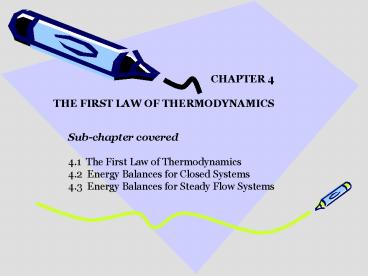THE FIRST LAW OF THERMODYNAMICS - PowerPoint PPT Presentation
1 / 16
Title:
THE FIRST LAW OF THERMODYNAMICS
Description:
A piston cylinder device content 25g of saturated water vapor that ... the total energy content, E remain constant) ... During the process, 30 kJ of heat is ... – PowerPoint PPT presentation
Number of Views:943
Avg rating:3.0/5.0
Title: THE FIRST LAW OF THERMODYNAMICS
1
CHAPTER 4 THE FIRST LAW OF THERMODYNAMICS
Sub-chapter covered 4.1 The First Law of
Thermodynamics 4.2 Energy Balances for Closed
Systems 4.3 Energy Balances for Steady Flow
Systems
2
The First Law of Thermodynamics
- The first law of thermodynamics is an expression
of the conservation of energy principle. - Energy can cross the boundaries of a closed
system in the form of heat or work. - Energy transfer across a system boundary due
solely to the temperature difference between a
system and its surroundings is called heat. - Work energy can be thought of as the energy
expended to lift a weight
3
- Energy Balances
- The net change in the total energy of the system
during a process is equal - to the difference between the total energy
entering and the total energy - leaving the system during that process
Change in the total energy of the system
Total energy entering the system
Total energy leaving the system
-
Ein - Eout ?Esystem
4
Energy Change of a System
Energy Change Energy at final state -
Energy at initial state
? Esystem Efinal - Einitial E2
- E1
? E ? U ? KE ? PE
where ? U m (u2 u1 ) ? KE ½ (m
)(V22 - V12) ? PE mg (z2 z1 )
5
- Mechanisms of Energy Transfer
- Heat Transfer, Q - Heat transfer to a system
(heat gain) increase the - energy of the molecules and the heat transfer
from a system (heat loss) - decrease the energy of the molecules.
- Work, W Energy interaction that is not caused
by a temperature difference - between system and surroundings.
- - Work transfer to a system
(work done on a system) increase the - energy of the system and work transfer from a
system (work done by the - system) decrease the energy of the system.
- Mass Flow, m Mass flow in and out of the
system as an additional - mechanism of energy transfer.
- - Mass enters a
system, increase the energy of the system - and mass leaves the system,
decrease the energy of the system
6
Ein - Eout ?Esystem
kJ
.
.
.
Ein - Eout ?Esystem
rate form
kW
ein - eout ?esystem
per unit mass
kJ/kg
7
Energy Balances for Closed Systems
- Closed system (control mass) no mass can
enter or leave a system
Overall energy balance Ein Eout (Qin Qout)
(Win Wout) (Emass,in Emass,out)
?Esystem
0
8
Various forms of the first law relation for
closed system
General Q - W ?E
Stationary system Q - W ?U
Per unit mass q - w ?e
9
- Example 1
- A piston cylinder device content 25g of
saturated water vapor that - is maintained at constant pressure of 300 kPa.
A résistance heater - within the cylinders turned on and passes
current of 0.2 A for 5 min - from a 12V source. At the same time, a heat
loss of 3.7 kJ occurs. - a) Show the process in P-v diagram
- b) Final specific enthalpy
- c) Final temperature of the process
10
Energy Balances for Steady Flow Systems
- steady flow process a process during which a
fluid flows through a - control volume steadily
- no intensive or extensive properties within the
control volume ( the mass, m - the volume, V and the total energy content, E
remain constant)
Under steady flow conditions
11
.
.
Mass balance for steady flow process min
mout Multiple inlets and exits ? mi ?
me One inlet and one exit m1 m2 or
?1V1A1 ?2V2A2
.
.
.
.
Energy Balance for Steady Flow Process
0 (steady)
Energy balance
(kW)
12
Energy can be transferred by heat, work and mass
only the general steady flow system can also be
written as
where
for inlet and exit
13
.
where Q heat transferred into the system
(heat input) W work produced by the system
(work output)
.
14
Steady flow for single stream
per unit mass
15
- Exercise
- Water is being heated in a closed pan on top of a
range while being - stirred by paddle wheel. During the process,
30 kJ of heat is - transferred to the water and 8 kJ of heat is
lost to the surrounding - air. The paddle wheel work amounts to 500
Nm. Determine the - final energy of the system if its initial
energy is 10 kJ
16
- Exercise
- A well insulated rigid tank contains 5 kg of
saturated liquid-vapor - mixture of water at 100 kPa. Initially
three quarters of the mass is in - the liquid phase. An electric resistor
placed in the tank is connected - to a 110V source and a current of 8 A flows
through the resistor when - the switch turned on. Determine how long it
will take to vaporize - all the liquid in the tank. Also show the
process on a T-v diagram with - respect to the saturation lines































